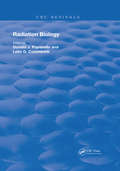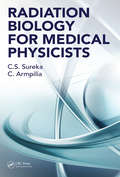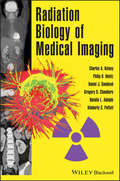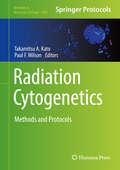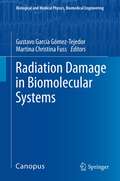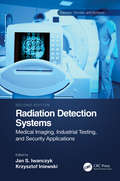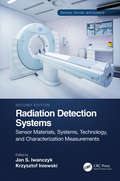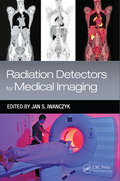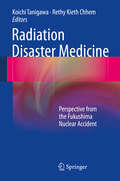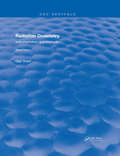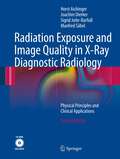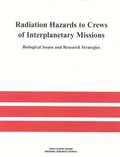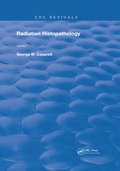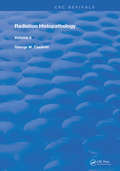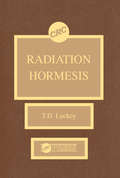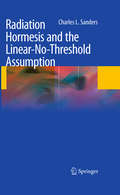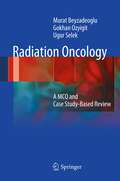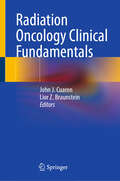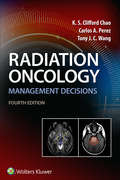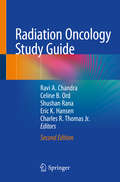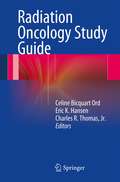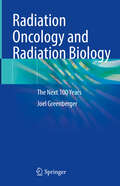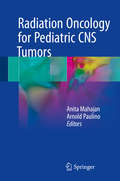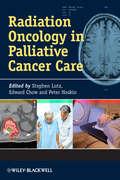- Table View
- List View
Radiation Biology (Routledge Revivals)
by Donald J. Pizzarello and Lelio G. ColombettiFirst Published in 1991, this book offers a full, comprehensive guide into the aspects of radiation and how it affects our bodies. Carefully compiled and filled with a vast repertoire of notes, diagrams, and references this book serves as a useful reference for Students of Radiology, and other practitioners in their respective fields.
Radiation Biology for Medical Physicists
by Christina Armpilia C. S. SurekaThis book is designed to convey as much information as possible in a concise and simple way to make it suitable for students, researchers and clinical medical physicists. Better meanings, codes and examples are included. Most of the basics are also covered for easy reference along with a glossary of objective-type questions. Upon completion of this textbook, the readers will gather knowledge about the physics, chemistry and biology of the human body towards cancer treatment using radiation.
Radiation Biology of Medical Imaging
by Kimberly S. Paffett Daniel J. Sandoval Philip H. Heintz Natalie L. Adolphi Gregory D. Chambers Charles A. KelseyThis book provides a thorough yet concise introduction to quantitative radiobiology and radiation physics, particularly the practical and medical application. Beginning with a discussion of the basic science of radiobiology, the book explains the fast processes that initiate damage in irradiated tissue and the kinetic patterns in which such damage is expressed at the cellular level. The final section is presented in a highly practical handbook style and offers application-based discussions in radiation oncology, fractionated radiotherapy, and protracted radiation among others. The text is also supplemented by a Web site.
Radiation Cytogenetics: Methods and Protocols (Methods in Molecular Biology #1984)
by Paul F. Wilson Takamitsu A. KatoThis book comprises a collection of chapters describing topics from traditional radiation cytogenetic analysis methods to the modern fluorescence based-analysis and high throughput automatic analysis methods. Cytogenetic analysis is important not only in order to understand radiation-induced DNA damage in cells, but it is also a standard biological method to estimate human radiation exposure in the radiation accidents. Therefore, we prepared a series of chapters not only covering biological aspects but also exploring radiation physics and radiation protection. Written for the highly successful Methods in Molecular Biology series, chapters include introductions to their respective topics, lists of the necessary materials and equipment, step-by-step, readily reproducible laboratory protocols, and tips on troubleshooting and avoiding known pitfalls. Authoritative and practical, Radiation Cytogenetics: Methods and Protocols serves both novices working on their first experiments as well as experienced researchers searching for tried-and-true techniques to adapt for their own laboratory.
Radiation Damage in Biomolecular Systems
by Martina Christina Fuss Gustavo García Gómez-TejedorSince the discovery of X-rays and radioactivity, ionizing radiations have been widely applied in medicine both for diagnostic and therapeutic purposes. The risks associated with radiation exposure and handling led to the parallel development of the field of radiation protection. Pioneering experiments done by Sanche and co-workers in 2000 showed that low-energy secondary electrons, which are abundantly generated along radiation tracks, are primarily responsible for radiation damage through successive interactions with the molecular constituents of the medium. Apart from ionizing processes, which are usually related to radiation damage, below the ionization level low-energy electrons can induce molecular fragmentation via dissociative processes such as internal excitation and electron attachment. This prompted collaborative projects between different research groups from European countries together with other specialists from Canada, the USA and Australia. This book summarizes the advances achieved by these research groups after more than ten years of studies on radiation damage in biomolecular systems. An extensive Part I deals with recent experimental and theoretical findings on radiation induced damage at the molecular level. It includes many contributions on electron and positron collisions with biologically relevant molecules. X-ray and ion interactions are also covered. Part II addresses different approaches to radiation damage modelling. In Part III biomedical aspects of radiation effects are treated on different scales. After the physics-oriented focus of the previous parts, there is a gradual transition to biology and medicine with the increasing size of the object studied. Finally, Part IV is dedicated to current trends and novel techniques in radiation reserach and the applications hence arising. It includes new developments in radiotherapy and related cancer therapies, as well as technical optimizations of accelerators and totally new equipment designs, giving a glimpse of the near future of radiation-based medical treatments.
Radiation Detection Systems: Medical Imaging, Industrial Testing, and Security Applications (Devices, Circuits, and Systems)
by Jan S. IwanczykThe advances in semiconductor detectors, scintillators, photodetectors such as silicon photomultipliers (SiPM), and readout electronics have experienced tremendous growth in recent years in terms of basic technologies and a variety of applications. The second edition of Radiation Detection Systems presents variety of radiation detection systems, giving readers a broad view of the state-of-the-art in the design of detectors, front-end electronics, and systems offering optimized choices of the detection tools for a particular application. The new edition has been divided into two volumes. This volume on Medical Imaging, Industrial Testing, and Security Applications presents specific applications of the detection systems in medical imaging, industrial testing, and security applications. These newely developed technologies play a vital role in the detection, diagnosis, and treatment of major human diseases. Featuring contributions from leading experts and pioneers in their respective fields, this book: Describes new advances in development of detection systems based on CdZnTe (CZT) and CdTe detectors utilizing a direct conversion of radiation to electric signals Reports a recent progress in technologies and performance of SiPM used for reading the light from scintillators Explores exciting new application opportunities created by development of the cutting-edge detection technologies in X-ray spectroscopy, computed tomography (CT), bone dosimetry, and nuclear medicine (PET, SPECT) Considers the future use of photon-counting detectors in clinical CT scanners providing K-edge imaging to reduce the amount of contrast agents and ultimately offering both an anatomical and a functional information Describes, uses of radiation detection systems in security applications such as luggage scanning, dirty bomb detection, and border control With its combined coverage of new materials and innovative new system approaches, as well as a succinct overview of recent developments, this book is an invaluable tool for any engineer, professional, or student working in electronics or an associated field. Readers can refer to the other volume, Sensor Materials, Systems, Technology, and Characterization Measurements, which puts emphasis on sensor materials, detector structures, front electronics technology, and their designs and system optimization for different applications.
Radiation Detection Systems: Sensor Materials, Systems, Technology, and Characterization Measurements (Devices, Circuits, and Systems)
by Jan S. IwanczykThe advances in semiconductor detectors, scintillators, photodetectors such as silicon photomultipliers (SiPM), and reaodut electronics have experienced tremendous growth in recent years in terms of basic technologies and variety of applications.The second edition of the book Radiation Detection Systems presents variety of radiation detection systems giving readers a broad view of the state-of–the-art in the design of detectors, front-end electronics and systems offering optimized choices of the detection tools for a particular application. The new edition has been divided into two volumes. This first volume, on Sensor Materials, Systems, Technology and Characterization Measurements puts emphasis on sensor materials, detector structures, front electronics technology and their designs as well as system optimization for different applications. Also, the book include characterization measurements of the developed detection systems. Featuring contributions from leading experts and pioneers in their respective fields, this book • describes progress in growth technologies of cadmium zinc telluride (CdZnTe) and cadmium telluride (CdTe) materials• shows variety of specific detector structure designs and their integration with front-end amplification/processing electronics• presents detection systems based on CdZnTe and CdTe detector technologies that are optimized for specific applications. The designed systems are characterized in terms of their spectral responses, spatial and timing resolutions• addresses incomplete charge collection, pulse pileup, charge sharing between neighboring detector pixels and other phenomena that can degrade the spectral response of photon-counting detectors• reports new developments of silicon photomultipliers used for reading the light from scintillators that starting to make a big impact particularly in the design concepts of novel medical instrumentation With its combined coverage of new materials and innovative new system approaches, as well as a succinct overview of recent developments, this book is an invaluable tool for any engineer, professional, or student working in electronics or an associated field. Readers can refer to the second book to get a detailed understanding of more specific applications of the detection systems in medical imaging, industrial testing and security applications.
Radiation Detectors for Medical Imaging (Devices, Circuits, and Systems)
by Jan S. IwanczykRadiation Detectors for Medical Imaging discusses the current state of the art and future prospects of photon-counting detectors for medical imaging applications. Featuring contributions from leading experts and pioneers in their respective fields, this book:Describes x-ray spectral imaging detectors based on cadmium zinc telluride (CdZnTe) and cad
Radiation Disaster Medicine
by Rethy Kieth Chhem Koichi TanigawaWhile many books are available on disaster medicine, none is specifically devoted to the role of physicians in the management of patients exposed to radiation leakage from a damaged nuclear power plant. Radiation Disaster Medicine aims to fill this void based on the response to the Fukushima nuclear accident. Each chapter addresses principles and practices of radiation medicine within the specific context of that accident. Topics covered include the role of physicians in radiation disasters, the concepts of external and internal exposure, prehospital and hospital response, disaster behavioral health, and radiation emergency response from the perspective of national and international institutions. Most of the contributors are active educators and researchers in radiation medicine with first-hand experience in dealing with prehospital triage and management of patients within secondary and tertiary care hospitals in Japan.
Radiation Dose from Multidetector CT
by Pierre Alain Gevenois Denis Tack Mannudeep K. KalraComputed tomography (CT) is a powerful technique providing precise and confident diagnoses. The burgeoning use of CT has resulted in an exponential increase in collective radiation dose to the population. Despite investigations supporting the use of lower radiation doses, surveys highlight the lack of proper understanding of CT parameters that affect radiation dose. Dynamic advances in CT technology also make it important to explain the latest dose-saving strategies in an easy-to-comprehend manner. This book aims to review all aspects of the radiation dose from CT and to provide simple rules and tricks for radiologists and radiographers that will assist in the appropriate use of CT technique. The second edition includes a number of new chapters on the most up-to-date strategies and technologies for radiation dose reduction while updating the outstanding contents of the first edition. Vendor perspectives are included, and an online image gallery will also be available to readers.
Radiation Dosimetry Instrumentation and Methods: Instrumentation And Methods (CRC Press Revivals)
by Gad ShaniRadiation dosimetry has made great progress in the last decade, mainly because radiation therapy is much more widely used. Since the first edition, many new developments have been made in the basic methods for dosimetry, i.e. ionization chambers, TLD, chemical dosimeters, and photographic films. Radiation Dosimetry: Instrumentation and Methods, Second Edition brings to the reader these latest developments. Written at a high level for medical physicists, engineers, and advanced dosimetrists, it concentrates only on evolvement during the last decade, relying on the first edition to provide the basics.
Radiation Exposure and Image Quality in X-Ray Diagnostic Radiology
by Joachim Dierker Horst Aichinger Manfred Säbel Sigrid Joite-BarfußThis completely updated second edition of Radiation Exposure and Image Quality in X-ray Diagnostic Radiology provides the reader with detailed guidance on the optimization of radiological imaging. The basic physical principles of diagnostic radiology are first presented in detail, and their application to clinical problems is then carefully explored. The final section is a supplement containing tables of data and graphical depictions of X-ray spectra, interaction coefficients, characteristics of X-ray beams, and other aspects relevant to patient dose calculations. In addition, a complementary CD-ROM contains a user-friendly Excel file database covering these aspects that can be used in the reader's own programs. This book will be an invaluable aid to medical physicists when performing calculations relating to patient dose and image quality, and will also prove useful for diagnostic radiologists and engineers.
Radiation Hazards to Crews of Interplanetary Missions: Biological Issues and Research Strategies
by Task Group on the Biological Effects of Space RadiationInformation on Radiation Hazards to Crews of Interplanetary Missions
Radiation Histopathology (Routledge Revivals #1)
by George W. CasarettFirst Published in 1980, this book offers comprehensive insight into the ways in which radiation changes diseased tissue. Carefully compiled and filled with a vast repertoire of notes, diagrams, and references this book serves as a useful reference for students of medicine and other practitioners in their respective fields.
Radiation Histopathology (Routledge Revivals #2)
by George W. CasarettFirst Published in 1980, this book offers comprehensive insight into the ways in which radiation changes diseased tissue. Carefully compiled and filled with a vast repertoire of notes, diagrams, and references this book serves as a useful reference for students of medicine and other practitioners in their respective fields.
Radiation Hormesis (Routledge Revivals Ser.)
by T. D. LuckeyRadiation Hormesis presents the only critical review of the effects of whole-body exposure to low doses of ionizing radiation in animals. This is a "must read" book for radiobiologists, health-conscious individuals, and serious environmentalists. Topics discussed include our radiation environment, radiation hormesis in cancer mortality, growth and development, reproduction and mutation, immunity, and cancer. Data is presented that indicates that low doses of ionizing radiation may actually be beneficial to human health. This information could invalidate the "zero thesis" and linear models used by most regulatory agencies. The implications regarding eliminating linear models and accepting radiation hormesis are also discussed.
Radiation Hormesis and the Linear-No-Threshold Assumption
by Charles L. SandersCurrent radiation protection standards are based upon the application of the linear no-threshold (LNT) assumption, which considers that even very low doses of ionizing radiation can cause cancer. The radiation hormesis hypothesis, by contrast, proposes that low-dose ionizing radiation is beneficial. In this book, the author examines all facets of radiation hormesis in detail, including the history of the concept and mechanisms, and presents comprehensive, up-to-date reviews for major cancer types. It is explained how low-dose radiation can in fact decrease all-cause and all-cancer mortality and help to control metastatic cancer. Attention is also drawn to biases in epidemiological research when using the LNT assumption. The author shows how proponents of the LNT assumption consistently reject, manipulate, and deliberately ignore an overwhelming abundance of published data and falsely claim that no reliable data are available at doses of less than 100 mSv.
Radiation Oncology
by Gokhan Ozyigit Murat Beyzadeoglu Ugur Selek'Radiation Oncology: MCQs for Exams' (ROME) will cover the essential aspects of radiation physics, radiobiology, and clinical radiation oncology designed to meet the needs of a large scale of examinees. Topics of this new book will be in the order of our previous "Basic Radiation Oncology" (Springer, 2010) with additional two new chapters (Pediatric tumors and Rare tumors-Benign Diseases) making a total of 15 chapters and instead of old style question and answer format,current MCQ examination pattern helpful for both oral exams and written exams is used in this comprehensive bedside recall book complementing the "Basic Radiation Oncology"1st Edition.
Radiation Oncology Clinical Fundamentals
by John J. Cuaron Lior Z. BraunsteinThis textbook presents a pragmatic approach to the principles and practices of radiation oncology as practiced at Memorial Sloan Kettering Cancer Center, incorporating recent clinical trial data and the latest techniques. It aims to clarify radiotherapy administration approaches that span the gamut across various technologies, both traditional and cutting edge. By synthesizing scientific literature and expert knowledge, the work connects theoretical concepts with practical application, addressing the challenge of navigating extensive research to inform treatment decisions. Indeed, this overall work serves as a guide for those seeking to develop a comprehensive understanding of current radiotherapy practices, focusing on clinical scenarios and evidence-based methods. Experts in each disease site have followed a structured approach, ensuring that readers have access to a logical, sequential, and thorough resource for various cancers, thus facilitating optimal patient care throughout the entire treatment continuum. By presenting information in this comprehensive manner, the textbook serves as an invaluable guide for medical students, residents, and attending physicians alike, bridging the gap between theoretical knowledge and practical application in the field of radiation oncology.
Radiation Oncology Management Decisions: Management Decisions
by Carlos A. Perez K. S. Clifford Chao Tony J. WangPublisher's Note: Products purchased from 3rd Party sellers are not guaranteed by the Publisher for quality, authenticity, or access to any online entitlements included with the product. Updated with details on the newest therapies and sporting a new full-color design, this latest edition of Radiation Oncology: Management Decisions continues to offer comprehensive guidance for residents as well as radiation oncologists already in professional practice. You’ll discover the latest treatment plans for numerous cancer sites and tumor types, including the mouth and sinus, gastrointestinal areas, lungs, bones, and blood. Concise, easy-to-read material you can use in a clinical setting immediately with patients!
Radiation Oncology Study Guide
by Charles R. Thomas Jr. Eric K. Hansen Ravi A. Chandra Celine B. Ord Shushan RanaNow in its second edition, this popular text remains a comprehensive study and review aid for the radiation oncology trainee and practicing radiation oncologist. The updated Radiation Oncology Study Guide, 2e maintains its robust Q&A format, and has been comprehensively updated to include the latest staging information and treatment methods. Answer rationales have been modified to a more readable, high yield bulleted format.Each chapter covers a major disease site and is divided into two main parts: Questions & Answers and Rationale. Questions review the scope of clinical practice, spanning from initial presentation to complications of treatment. General content and work-up questions emphasize “pearls” of epidemiology, anatomy, pathology, clinical presentation, and staging. Treatment content questions not only review evidence-based data guiding treatment recommendations, but also practical aspects of radiation treatment planning, pertinent radiobiology and physics, and complications of treatment. This book is an ideal resource for physicians-in-training to prepare for initial written and oral exams and physicians in practice to maintain their skills and prepare for maintenance of certification longitudinal and written exams.
Radiation Oncology Study Guide
by Charles R. Thomas Jr. Eric K. Hansen Celine Bicquart OrdRadiation Oncology Study Guide is a comprehensive study aid for radiation oncology residents preparing for the American Board of Radiology Radiation Oncology Initial Certification board exam. Presenting the fundamental principles of radiation oncology, the book covers the most salient and commonly tested facts on the exam. Organized by specific disease sites, each chapter presents a series of questions and answers that present clinical features, staging, principles of treatment, and evidence-based studies that guide treatment recommendations, with an emphasis on radiotherapy studies. The book offers over 1,000 multiple-choice questions with detailed answers and rationales.
Radiation Oncology and Radiation Biology: The Next 100 Years
by Joel GreenbergerThis book presents the fields of radiation oncology and radiation biology and projects the potential changes over the next 100 years. The first section describes the status of the medical specialty of radiation oncology and offers predictions for the evolution of the specialty over the next decades. The second section deals with the predictions of the future of radiation biology. This more comprehensive and detailed section deals with two major categories: space travel and the medical and physiological consequences of long-term exposure to space irradiation, and the late effects of ionizing irradiation on humans who have received therapeutic radiotherapy. Expanding use of high dose rate, small volume targeted stereotactic radiosurgery, and stereotactic ablative radiosurgery is expected to increase the numbers of long-term surviving patients. The medical, physiological, and radiobiological consequences of radiation late effect is described in detail. The current novel techniques of radiotherapy including FLASH irradiation, high LET particle irradiation, and novel strategies for a theranostics (combined radiographic diagnosis of metastatic deposits, and delivery of therapeutic radiation) are described, as well as the use of clinical radioisotopes in cancer therapy. This is an ideal guide for radiation oncologists and trainees who are particularly interested in where the field will progress over the next 100 years.
Radiation Oncology for Pediatric CNS Tumors
by Anita Mahajan Arnold PaulinoThis book reviews the principles and applications of radiotherapy in the management of pediatric brain tumors to allow the reader to gain a full appreciation of the major aspects involved in caring for these patients. Individual sections are devoted to basic principles, specific management for the full range of tumor entities, radiotherapy techniques, and potential toxicities and their management. The book is written and edited by world leaders in pediatric radiotherapy, and care has been taken to cover the latest advances in diagnosis and radiotherapy techniques. Pediatric brain tumors represent a diverse group of neoplasms that require carefully planned management for successful definitive treatment. Radiotherapy is one of the fundamental components in treatment for the majority of these vulnerable patients. The optimal radiation therapy approach will depend on multiple factors, including tumor type and location, extent of disease, age of the patient, and other therapies. A thorough understanding of the natural history of the disease, communication with the multidisciplinary team, full knowledge of available radiotherapy techniques, and consideration of potential acute and late toxicities are therefore essential for each patient.
Radiation Oncology in Palliative Cancer Care
by Peter Hoskin Edward Chow Stephen Lutz"This textbook, Radiation Oncology in Palliative Cancer Care, represents the full evolution of radiation therapy, and of oncology in general. ( ... ) [It] is an acknowledgment that palliative radiotherapy is now a sub-specialty of radiation oncology. This formally makes palliative radiotherapy a priority within patient care, academic research, quality assurance, and medical education." - From the Foreword by Nora Janjan, MD, MPSA, MBA, National Center for Policy Analysis, Dallas, TX, USAPalliative Medicine is the professional medical practice of prevention and relief of suffering and the support of the best possible quality of life for patients and their families, regardless of the stage of the disease or the need for other therapies. The most common cause for palliative care referral is terminal cancer, and a large proportion of those referrals include patients who will need palliative radiotherapy during the course of their disease. Still, there are barriers to coordinated care between radiation oncologists and palliative care physicians that differ from one country to another. Until now, one overarching limitation to appropriate concurrent care between the specialties across all countries has been the lack of a comprehensive yet concise reference resource that educates each of the specialties about the potential synergistic effects of their cooperation. This book fills that void.Radiation Oncology in Palliative Cancer Care:Is the first book-length treatment of this important topic available on the marketIs authored by world-renowned experts in radiation oncology and palliative medicineUses a multidisciplinary approach to content and patient treatmentFeatures decision trees for palliative radiotherapy based upon factors such as patient performance status and prognosisPays careful attention to current best practices and controversies in the delivery of end-of-life cancer careThis book is an important resource for practicing radiation oncologists and radiation oncologists in training, as well as hospice and palliative medicine physicians and nurses, medical oncologists, and geriatricians.
